
USDA monthly supply and demand reports normally led the news flow, and last week’s numbers from the government did make a few waves. But there are plenty of other ripples moving through the markets, including what could be the light at the end of the tunnel for sky-high fertilizer prices.
Indeed, while nearby corn and soybean futures made new contract highs, nitrogen and other nutrients showed signs of weakness.
Selling pressure was most evident in urea after India’s latest big tender brought out sellers, including a few low-ball offers below $545 a short ton delivered. Futures at the Gulf tumbled to as low as $510 in late January before the tender, then recovered to $632.50 when the deal was floated. The nearby traded down to $555 when news of lower offers hit the wire, though they recovered to $587.50 as traders wait to see how much India will actually book. Ideas the final tally will be short of the country’s needs helped firm prices, though they remain nearly 40% off record highs near $900 hit in November.
Look for urea deals
Average retail prices for urea are still near record levels, but the slide allowed some dealers refiling inventory to slash offers $125 to $150 a ton, with some back below $800. A few even cut ammonia costs, though even those are only $100 below our average of $1,461. Delayed production from a new Saudi plant could help support prices into spring.
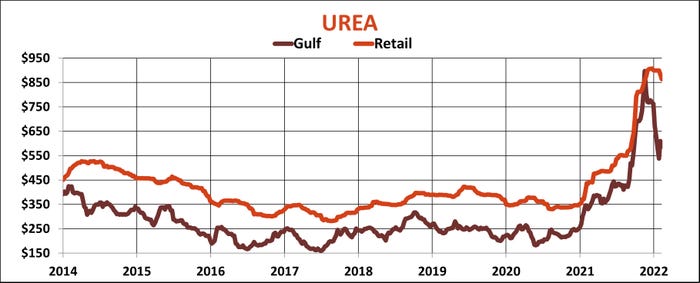
The lower nitrogen bill even produced a little pressure on DAP, though Gulf prices rallied back to $732.50, after a brief set back in January. Average retail DAP prices are still around $865, however, as net imports in 2021 fell by nearly 1.5 million tons. In addition to tariffs against imports from Russia and Morocco, exports from China dropped 41% from October through December after the government there pushed manufacturers to keep product at home to control prices. Chinese urea shipments fell by half in the fall, though higher prices also reduced demand from buyers around the world preferring to sit and wait. U.S net urea imports in December dropped 64%, falling 30% for the year as U.S. prices were generally the cheapest on the world stage.
Stronger imports helped boost year-end ammonia stocks in the U.S., but potash and phosphate rock stocks declined after record applications. Potash prices remain fairly resilient due to fears shipments from Belarus, and perhaps even Russia, may be sidetracked by international sanctions, if not all-out war.
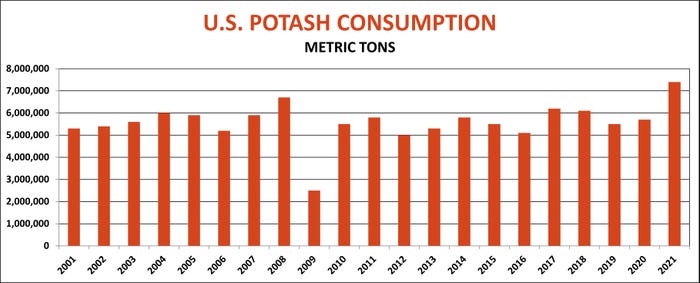
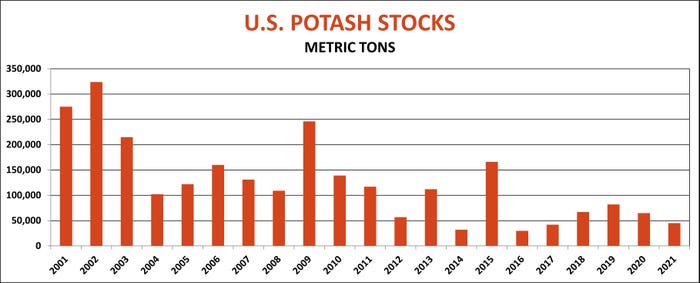
China cuts soybean imports
The fertilizer froth came as corn and soybeans rallied despite forecast for stocks and South American production that were generally above trade estimates. USDA made only one change to the U.S. side of the equation, cutting 2021-22 soybean ending stocks by 25 million to 325 million bushels due to stronger crush.
Processor margins are down from the lofty levels above $2 a bushel seen at the end of 2021, but remain attractive as end users scramble to lock up supplies in the face of drought in Argentina, the world’s largest soy product exporter. USDA cut its forecast of South American bean production, though not as much as bulls expect. Vegetation Health Index readings suggest final output could be 7% below USDA’s current estimates.
USDA did make one significant adjustment, knocking 3% off its forecast for soybean imports by China. That move wasn’t a shock, because imports from September through December fell 17% from the previous year. Chinese interest in U.S. cargoes appears to have picked up recently, though total commitments are off 28%.
Lower South American production would leave China and other buyers with few alternatives to U.S. supplies. But even anticipating that boost, futures hit some rarified air this week. My forecasting model puts the top third of the futures selling range at $16.04. Prices have already topped that level, reaching $16.33, but wouldn’t be expected to stay there for more than a week total without further bullish developments.
Corn target hit
La Nina cooling of the equatorial Pacific is blamed again for this year’s troubles in South America. The latest forecast out Thursday called for the phase of the El Nino cycle to end by the U.S. summer growing season, when it is associated with some of the big-time droughts on record.
Though La Nina has cut Argentine corn yields, it’s still far too early to tell the impact on Brazilian corn, much of which is just being planted now behind soybeans. USDA made no changes to its U.S. balance sheet, keeping projected carryout at 1.54 billion bushels. Shrinking beef and hog herds could ultimately impact feed usage, while the future of demand from ethanol plants and exporters remains unclear.
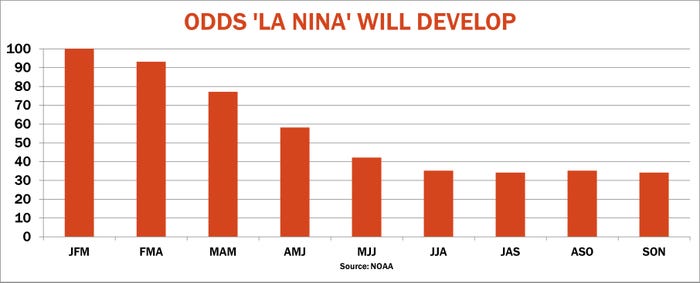
USDA forecasts a 5.9% increase in corn usage to make the biofuel this year, a little below the production forecast from the U.S. Energy Information Administration, which reports output up nearly 8%. Plants cut back in February, however, as margins fell in January due to weaker ethanol prices and higher corn costs.
Exports so far and a strong book of unshipped sales suggest business could be a little stronger than USDA currently forecast, but must overcome a slow start to the shipping season. A smaller Brazilian crop would help those odds.
My model currently puts the top of the selling range for nearby corn at $6.53, a dime from last week’s top. As with soybeans, this suggests the bull must be fed to keep the market rising. But with U.S. growing season weather and uncertainty over 2022 acreage, surprises could still come.
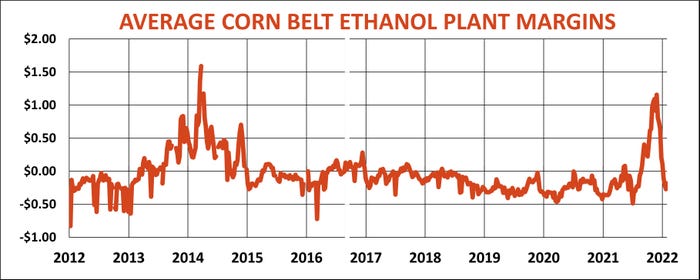
Fuel costs pace inflation
Higher corn and soybean prices fed into the big financial market narrative from last week, which again focused on inflation. The Consumer Price Index hit 7.5% over the past year, the highest since 1983. The news raised fears the Federal Reserve will move more aggressively to raise interest rates and tighten monetary policy at its next meeting a month from now in March. Current betting on Federal Funds futures at one point last week indicated a 97% chance of a half-point hike, with a 50-50 chance of a full 2% move over the next year.
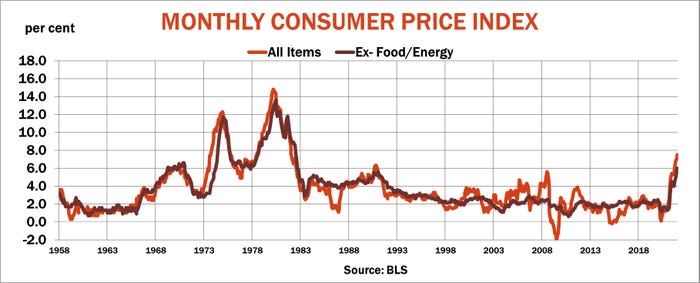
Those prospects raised current rates on the benchmark 10-Year Treasury Note past 2% for the first time since July 2019. Higher Treasury yields tend to support the value of the U.S. dollar, despite inflationary pressure and a surging trade deficit reported last week for 2021. The strong greenback appears fairly priced at current levels, which is typically bearish for dollar-denominated commodities, but don’t tell that to grains or energy.
Crude oil traded above $94 last week, reaching the top of my forecast range given current supply and demand fundamentals. New fears about global tightness in diesel supplies also emerged last week. That train has already left the station for farmers still needing to book spring fuel needs, with Chicago wholesale prices above $2.75 a gallon following a 75-cent move since December that took costs to their highest level since 2014. Farmgate prices usually run around 50 cents higher.
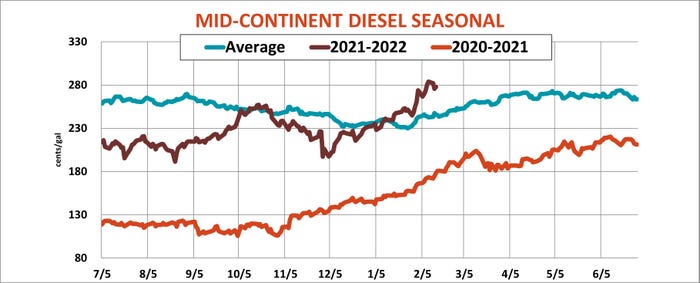
Growers might still catch a better price on propane for fall drying – if winter fades quickly and crude oil doesn’t take off towards triple digits. Prices normally sell off into the end of winter and early spring, with a summer break also possible. Wholesale costs are around 25 cents off last fall’s peak above $1.50 a gallon but farm-delivered quantities likely will be 65 to 75 more.
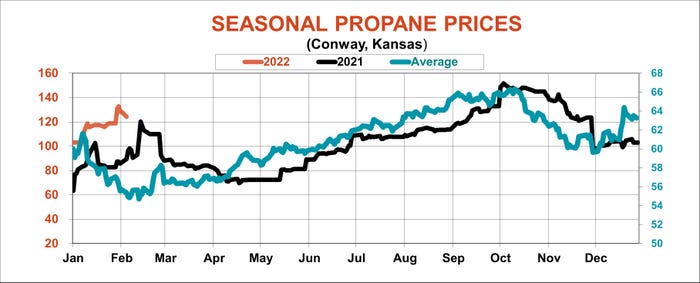
About the Author(s)
You May Also Like






